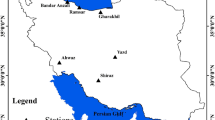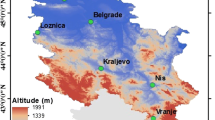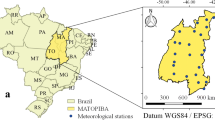Abstract
The reference crop evapotranspiration (ET0) is one of the major components of the hydrological cycle, and its prediction is of great importance in agricultural operations, especially irrigation, of field and horticultural crops. The present study aims to evaluate the performances of two stochastic and machine learning models in predicting ET0 for Mazandaran province, which is one of the most important centers of rice cultivation (as a high-water use plant) in Iran. The studied data belong to 5 synoptic stations in Mazandaran province. They include minimum, maximum, and mean air temperature, minimum, maximum, and mean relative humidity, wind speed, and sunshine duration. These data are received on a daily basis from the Iranian Meteorological Organization during the period 2003–2018. Then, these variables and the FAO-56 Penman-Monteith model are used to calculate daily ET0 rates. Moreover, stochastic models including autoregressive (AR), moving average (MA), autoregressive moving average (ARMA), and autoregressive integrated moving average (ARIMA), and machine learning models including least square support vector machine (LSSVM), adaptive neuro-fuzzy inference system (ANFIS), and generalized regression neural network (GRNN) are used to predict ET0. Predictor inputs include ET0 time lags selected by Autocorrelation Function (ACF) and partial ACF (PACF). The time series models of ARMA and ARIMA, and the machine learning model of LSSVM provide the most accurate predictions with the slight superiority of ARMA and ARIMA over LSSVM in most cases. As a result, it is found that stochastic models are superior to machine learning models due to their more accurate prediction and less complexity. The ARMA model (root mean square error = 0.623\(\frac{mm}{day}\), Wilmott index = 0.962, and R2 = 86.22%) shows the highest prediction accuracy. The current approach can be applied to predict irrigation water requirements and has research value under similar or different climatic conditions.










Similar content being viewed by others
Availability of data and materials
The datasets used and/or analyzed during the current study are available from the corresponding author on reasonable request.
References
Aghelpour P, Varshavian V (2020) Evaluation of stochastic and artificial intelligence models in modeling and predicting of river daily flow time series. Stoch Env Res Risk Assess 34(1):33–50. https://doi.org/10.1007/s00477-019-01761-4
Aghelpour P, Varshavian V (2021) Forecasting different types of droughts simultaneously using multivariate standardized Precipitation Index (MSPI), MLP neural network, and imperialistic competitive algorithm (ICA). Complexity, 2021. https://doi.org/10.1155/2021/6610228
Aghelpour P, Guan Y, Bahrami-Pichaghchi H, Mohammadi B, Kisi O, Zhang D (2020) Using the MODIS sensor for snow cover modeling and the assessment of drought effects on snow cover in a mountainous area. Remote Sens 12(20):3437. https://doi.org/10.3390/rs12203437
Aghelpour P, Bahrami-Pichaghchi H, Varshavian V (2021a) Hydrological drought forecasting using multi-scalar streamflow drought index, stochastic models and machine learning approaches. North Iran Stoch Environ Res Risk Assess 1–21. https://doi.org/10.1007/s00477-020-01949-z
Aghelpour P, Kisi O, Varshavian V (2021b) Multivariate drought forecasting in short-and long-term horizons using MSPI and data-driven approaches. J Hydrol Eng 26(4):04021006. https://doi.org/10.1061/(ASCE)HE.1943-5584.0002059
Aghelpour P, Mohammadi B, Mehdizadeh S, Bahrami-Pichaghchi H, Duan Z (2021c) A novel hybrid dragonfly optimization algorithm for agricultural drought prediction. Stoch Env Res Risk Assess 1–19. https://doi.org/10.1007/s00477-021-02011-2
Aghelpour P, Bahrami-Pichaghchi H, Varshavian V, Graf R, Gholami Sefidkouhi MA, Khoshravesh M (2022) Evaluating the impact of large-scale climatic indices as inputs for forecasting monthly river flow in Mazandaran Province, Iran. Pure Appl Geophys 1–23. https://doi.org/10.1007/s00024-022-02970-9
Ahmadi F, Mehdizadeh S, Mohammadi B, Pham QB, Doan TNC, Vo ND (2021) Application of an artificial intelligence technique enhanced with intelligent water drops for monthly reference evapotranspiration estimation. Agric Water Manage 244:106622. https://doi.org/10.1016/j.agwat.2020.106622
Akhter S, Eibek KU, Islam S, Islam ARMT, Chu R, Shuanghe S (2019) Predicting spatiotemporal changes of channel morphology in the reach of Teesta River, Bangladesh using GIS and ARIMA modeling. Quatern Int 513:80–94. https://doi.org/10.1016/j.quaint.2019.01.022
Alizamir M, Kisi O, Adnan M, Kuriqi A (2020) Modelling reference evapotranspiration by combining neuro-fuzzy and evolutionary strategies. Acta Geophys 68:1113–1126. https://doi.org/10.1007/s11600-020-00446-9
Allen RG, Pereira LS, Raes D, Smith M (1998) Crop evapotranspiration-guidelines for computing crop water requirements-FAO Irrigation and drainage paper 56, vol 300. Fao, Rome, p D05109. 9
Anda A, Soos G, da Silva JAT, Kozma-Bognar V (2015) Regional evapotranspiration from a wetland in Central Europe, in a 16-year period without human intervention. Agric For Meteorol 205:60–72. https://doi.org/10.1016/j.agrformet.2015.02.010
Arca B, Duce P, Snyder RL, Spano D, Fiori M (2003), September Use of numerical weather forecast and time series models for predicting reference evapotranspiration. In: IV International Symposium on irrigation of horticultural crops 664 (pp. 39–46). https://doi.org/10.17660/ActaHortic.2004.664.2
Ashrafzadeh A, Kişi O, Aghelpour P, Biazar SM, Masouleh MA (2020) Comparative study of time series models, support vector machines, and GMDH in forecasting long-term evapotranspiration rates in northern Iran. J Irrig Drain Eng 146(6):04020010. https://doi.org/10.1061/(ASCE)IR.1943-4774.0001471
Bezdek JC (2013) Pattern recognition with fuzzy objective function algorithms. Springer, Berlin
Biazar SM, Rahmani V, Isazadeh M, Kisi O, Dinpashoh Y (2020) New input selection procedure for machine learning methods in estimating daily global solar radiation. Arab J Geosci 13:1–17. https://doi.org/10.1007/s12517-020-05437-0
Box GE, Jenkins GM (1976) Time series analysis: forecasting and control. Holden dsy. Inc. California
Chia MY, Huang YF, Koo CH (2020) Support vector machine enhanced empirical reference evapotranspiration estimation with limited meteorological parameters. Comput Electron Agric 175:105577. https://doi.org/10.1016/j.compag.2020.105577
Chia MY, Huang YF, Koo CH (2021) Improving reference evapotranspiration estimation using novel inter-model ensemble approaches. Comput Electron Agric 187:106227. https://doi.org/10.1016/j.compag.2021.106227
Cobaner M (2011) Evapotranspiration estimation by two different neuro-fuzzy inference systems. J Hydrol 398(3–4):292–302. https://doi.org/10.1016/j.jhydrol.2010.12.030
Dayal D, Swain S, Gautam AK, Palmate SS, Pandey A, Mishra SK (2019) May). Development of ARIMA model for monthly rainfall forecasting over an Indian river Basin. World Environmental and Water Resources Congress 2019: Watershed Management, Irrigation and Drainage, and Water Resources Planning and Management. American Society of Civil Engineers, Reston, VA, pp 264–271. https://doi.org/10.1061/9780784482339.027
Deo RC, Samui P, Kim D (2016) Estimation of monthly evaporative loss using relevance vector machine, extreme learning machine and multivariate adaptive regression spline models. Stoch Env Res Risk Assess 30(6):1769–1784. https://doi.org/10.1007/s00477-015-1153-y
Dunn JC (1973) A fuzzy relative of the ISODATA process and its use in detecting compact well-separated clusters. https://doi.org/10.1080/01969727308546046
e Lucas PDO, Alves MA, Silva e, Guimarães FG (2020) Reference evapotranspiration time series forecasting with ensemble of convolutional neural networks. Comput Electron Agric 177:105700. https://doi.org/10.1016/j.compag.2020.105700
Emadi A, Zamanzad-Ghavidel S, Fazeli S, Zarei S, Rashid-Niaghi A (2021) Multivariate modeling of pan evaporation in monthly temporal resolution using a hybrid evolutionary data-driven method (case study: Urmia Lake and Gavkhouni basins). Environ Monit Assess 193(6):1–32. https://doi.org/10.1007/s10661-021-09060-8
Feng G, Cobb S, Abdo Z, Fisher DK, Ouyang Y, Adeli A, Jenkins JN (2016) Trend analysis and forecast of precipitation, reference evapotranspiration, and rainfall deficit in the Blackland Prairie of Eastern Mississippi. J Appl Meteorol Climatol 55(7):1425–1439. https://doi.org/10.1175/JAMC-D-15-0265.1
Ferreira LB, da Cunha FF, de Oliveira RA, Fernandes Filho EI (2019) Estimation of reference evapotranspiration in Brazil with limited meteorological data using ANN and SVM–A new approach. J Hydrol 572:556–570. https://doi.org/10.1016/j.jhydrol.2019.03.028
Gautam R, Sinha AK (2016) Time series analysis of reference crop evapotranspiration for Bokaro District, Jharkhand, India. J Water Land Devhttps://doi.org/10.1515/jwld-2016-0021
Ghorbani MA, Deo RC, Karimi V, Kashani MH, Ghorbani S (2019) Design and implementation of a hybrid MLP-GSA model with multi-layer perceptron-gravitational search algorithm for monthly lake water level forecasting. Stoch Env Res Risk Assess 33(1):125–147. https://doi.org/10.1007/s00477-018-1630-1
Gocić M, Motamedi S, Shamshirband S, Petković D, Ch S, Hashim R, Arif M (2015) Soft computing approaches for forecasting reference evapotranspiration. Comput Electron Agric 113:164–173. https://doi.org/10.1016/j.compag.2015.02.010
Gorantiwar SD, Meshram DT, Mittal HK (2011) Seasonal ARIMA model for generation and forecasting evapotranspirtion of Solapur district of Maharashtra. J Agrometeorol 13(2):119–122
Graf R, Aghelpour P (2021) Daily river water temperature prediction: a comparison between neural network and stochastic techniques. Atmosphere 12(9):1154. https://doi.org/10.3390/atmos12091154
Guo X, Sun X, Ma J (2011) Prediction of daily crop reference evapotranspiration (ET0) values through a least-squares support vector machine model. Hydrol Res 42(4):268–274. https://doi.org/10.2166/nh.2011.072
Hamdi MR, Bdour AN, Tarawneh ZS (2008) Developing reference crop evapotranspiration time series simulation model using Class a Pan: a case study for the Jordan Valley/Jordan. Jordan J Earth Environ Sci 1(1):33–44
Jang JS (1993) ANFIS: adaptive-network-based fuzzy inference system. IEEE Trans Syst Man Cybern 23(3):665–685. https://doi.org/10.1109/21.256541
Jiang Q, Christakos G (2018) Space-time mapping of ground-level PM 2.5 and NO 2 concentrations in heavily polluted northern China during winter using the Bayesian maximum entropy technique with satellite data. Air Qual Atmos Health 11(1):23–33. https://doi.org/10.1007/s11869-017-0514-8
Karbasi M (2018) Forecasting of multi-step ahead reference evapotranspiration using wavelet-Gaussian process regression model. Water Resour Manage 32(3):1035–1052. https://doi.org/10.1007/s11269-017-1853-9
Keshtegar B, Kisi O, Arab HG, Zounemat-Kermani M (2018) Subset modeling basis ANFIS for prediction of the reference evapotranspiration. Water Resour Manage 32(3):1101–1116. https://doi.org/10.1007/s11269-017-1857-5
Kim S, Singh VP, Seo Y, Kim HS (2014) Modeling nonlinear monthly evapotranspiration using soft computing and data reconstruction techniques. Water Resour Manage 28(1):185–206. https://doi.org/10.1007/s11269-013-0479-9
Kishore V, Pushpalatha M (2017) Forecasting Evapotranspiration for Irrigation Scheduling using Neural Networks and ARIMA. Int J Appl Eng Res 12(21):10841–10847
KIŞI Ö (2006) Generalized regression neural networks for evapotranspiration modelling. Hydrol Sci J 51(6):1092–1105. https://doi.org/10.1623/hysj.51.6.1092
Kisi O (2013) Least squares support vector machine for modeling daily reference evapotranspiration. Irrig Sci 31(4):611–619. https://doi.org/10.1007/s00271-012-0336-2
Kişi O, Cimen M (2009) Evapotranspiration modelling using support vector machines/Modélisation de l’évapotranspiration à l’aide de ‘support vector machines’. Hydrol Sci J 54(5):918–928. https://doi.org/10.1623/hysj.54.5.918
Kisi O, Zounemat-Kermani M (2014) Comparison of two different adaptive neuro-fuzzy inference systems in modelling daily reference evapotranspiration. Water Resour Manage 28(9):2655–2675. https://doi.org/10.1007/s11269-014-0632-0
Kisi O, Shiri J, Karimi S, Adnan RM (2018) Three different adaptive neuro fuzzy computing techniques for forecasting long-period daily streamflows. Big data in engineering applications. Springer, Singapore, pp 303–321. https://doi.org/10.1007/978-981-10-8476-8_15
Kumar M, Kar IN (2009) Non-linear HVAC computations using least square support vector machines. Energy Conv Manag 50(6):1411–1418. https://doi.org/10.1016/j.enconman.2009.03.009
Ladlani I, Houichi L, Djemili L, Heddam S, Belouz K (2012) Modeling daily reference evapotranspiration (ET 0) in the north of Algeria using generalized regression neural networks (GRNN) and radial basis function neural networks (RBFNN): a comparative study. Meteorol Atmos Phys 118(3):163–178. https://doi.org/10.1007/s00703-012-0205-9
Landeras G, Ortiz-Barredo A, López JJ (2009) Forecasting weekly evapotranspiration with ARIMA and artificial neural network models. J Irrig Drain Eng 135(3):323–334. https://doi.org/10.1061/(ASCE)IR.1943-4774.0000008
Mehdizadeh S, Behmanesh J, Khalili K (2017) Using MARS, SVM, GEP and empirical equations for estimation of monthly mean reference evapotranspiration. Comput Electron Agric 139:103–114. https://doi.org/10.1016/j.compag.2017.05.002
Mohammadi B, Mehdizadeh S (2020) Modeling daily reference evapotranspiration via a novel approach based on support vector regression coupled with whale optimization algorithm. Agric Water Manage 237:106145. https://doi.org/10.1016/j.agwat.2020.106145
Mohammadi B, Guan Y, Moazenzadeh R, Safari MJS (2021a) Implementation of hybrid particle swarm optimization-differential evolution algorithms coupled with multi-layer perceptron for suspended sediment load estimation. CATENA 198:105024. https://doi.org/10.1016/j.catena.2020.105024
Mohammadi B, Mehdizadeh S, Ahmadi F, Lien NTT, Linh NTT, Pham QB (2021b) Developing hybrid time series and artificial intelligence models for estimating air temperatures. Stoch Env Res Risk Assess 35(6):1189–1204. https://doi.org/10.1007/s00477-020-01898-7
Mohan S, Arumugam N (1995) Forecasting weekly reference crop evapotranspiration series. Hydrol Sci J 40(6):689–702. https://doi.org/10.1080/02626669509491459
Nourani V, Elkiran G, Abdullahi J (2020) Multi-step ahead modeling of reference evapotranspiration using a multi-model approach. J Hydrol 581:124434. https://doi.org/10.1016/j.jhydrol.2019.124434
Park J, Sandberg IW (1991) Universal approximation using radial-basis-function networks. Neural Comput 3(2):246–257. https://doi.org/10.1162/neco.1991.3.2.246
Patil AP, Deka PC (2017) Performance evaluation of hybrid Wavelet-ANN and Wavelet-ANFIS models for estimating evapotranspiration in arid regions of India. Neural Comput Appl 28(2):275–285. https://doi.org/10.1007/s00521-015-2055-0
Pour-Ali Baba A, Shiri J, Kisi O, Fard AF, Kim S, Amini R (2013) Estimating daily reference evapotranspiration using available and estimated climatic data by adaptive neuro-fuzzy inference system (ANFIS) and artificial neural network (ANN). Hydrol Res 44(1):131–146. https://doi.org/10.2166/nh.2012.074
Raza A, Shoaib M, Faiz MA, Baig F, Khan MM, Ullah MK, Zubair M (2020) Comparative assessment of reference evapotranspiration estimation using conventional method and machine learning algorithms in four climatic regions. Pure Appl Geophys 177(9):4479–4508. https://doi.org/10.1007/s00024-020-02473-5
Roy DK, Barzegar R, Quilty J, Adamowski J (2020) Using ensembles of adaptive neuro-fuzzy inference system and optimization algorithms to predict reference evapotranspiration in subtropical climatic zones. J Hydrol 591:125509. https://doi.org/10.1016/j.jhydrol.2020.125509
Ruiming F, Shijie S (2020) Daily reference evapotranspiration prediction of Tieguanyin tea plants based on mathematical morphology clustering and improved generalized regression neural network. Agric Water Manage 236:106177. https://doi.org/10.1016/j.agwat.2020.106177
Salas JD (1980) Applied modeling of hydrologic time series. Water Resources Publication, Littleton
Sanikhani H, Kisi O, Maroufpoor E, Yaseen ZM (2019) Temperature-based modeling of reference evapotranspiration using several artificial intelligence models: application of different modeling scenarios. Theoret Appl Climatol 135(1):449–462. https://doi.org/10.1007/s00704-018-2390-z
Seifi A, Riahi H (2020) Estimating daily reference evapotranspiration using hybrid gamma test-least square support vector machine, gamma test-ANN, and gamma test-ANFIS models in an arid area of Iran. J Water Clim Change 11(1):217–240. https://doi.org/10.2166/wcc.2018.003
Shiri J, Zounemat-Kermani M, Kisi O, Karimi M, S (2020) Comprehensive assessment of 12 soft computing approaches for modelling reference evapotranspiration in humid locations. Meteorol Appl 27(1):e1841. https://doi.org/10.1002/met.1841
Specht DF (1991) A general regression neural network. IEEE Trans Neural Netw 2(6), 568–576. https://doi.org/10.1109/72.97934
Suykens JA, Vandewalle J (1999) Least squares support vector machine classifiers. Neural Process Lett 9(3):293–300. https://doi.org/10.1023/A:1018628609742
Tabari H, Kisi O, Ezani A, Talaee PH (2012) SVM, ANFIS, regression and climate based models for reference evapotranspiration modeling using limited climatic data in a semi-arid highland environment. J Hydrol 444:78–89. https://doi.org/10.1016/j.jhydrol.2012.04.007
Tabari H, Martinez C, Ezani A, Talaee PH (2013) Applicability of support vector machines and adaptive neurofuzzy inference system for modeling potato crop evapotranspiration. Irrig Sci 31(4):575–588. https://doi.org/10.1007/s00271-012-0332-6
Takagi T, Sugeno M (1985) Fuzzy identification of systems and its applications to modeling and control. IEEE Trans Syst Man Cybern 1116–132. https://doi.org/10.1109/TSMC.1985.6313399
Tao H, Diop L, Bodian A, Djaman K, Ndiaye PM, Yaseen ZM (2018) Reference evapotranspiration prediction using hybridized fuzzy model with firefly algorithm: Regional case study in Burkina Faso. Agric Water Manage 208:140–151. https://doi.org/10.1016/j.agwat.2018.06.018
Wu L, Peng Y, Fan J, Wang Y (2019) Machine learning models for the estimation of monthly mean daily reference evapotranspiration based on cross-station and synthetic data. Hydrol Res 50(6):1730–1750. https://doi.org/10.2166/nh.2019.060
Xu D, Zhang Q, Ding Y, Zhang D (2021) Application of a hybrid ARIMA-LSTM model based on the SPEI for drought forecasting. Environ Sci Pollut Res pp 1–17
Yin Z, Wen X, Feng Q, He Z, Zou S, Yang L (2017) Integrating genetic algorithm and support vector machine for modeling daily reference evapotranspiration in a semi-arid mountain area. Hydrol Res 48(5):1177–1191. https://doi.org/10.2166/nh.2016.205
Zadeh LA (1965) Information and control. Fuzzy Sets 8(3):338–353
Zeinolabedini Rezaabad M, Ghazanfari S, Salajegheh M (2020) ANFIS modeling with ICA, BBO, TLBO, and IWO optimization algorithms and sensitivity analysis for predicting daily reference evapotranspiration. J Hydrol Eng 25(8):04020038. https://doi.org/10.1061/(ASCE)HE.1943-5584.0001963
Zhang Y, Li W, Chen Q, Pu X, Xiang L (2017) Multi-models for SPI drought forecasting in the north of Haihe River Basin, China. Stoch Env Res Risk Assess 31(10):2471–2481. https://doi.org/10.1007/s00477-017-1437-5
Zhang Y, Zhao Z, Zheng J (2020) CatBoost: a new approach for estimating daily reference crop evapotranspiration in arid and semi-arid regions of Northern China. J Hydrol 588:125087. https://doi.org/10.1016/j.jhydrol.2020.125087
Chia MY, Huang YF, Koo CH (2022) Resolving data-hungry nature of machine learning reference evapotranspiration estimating models using inter-model ensembles with various data management schemes. Agric Water Manage 261:107343. https://doi.org/10.1016/j.agwat.2021.107343
Deo RC, Ghorbani MA, Samadianfard S, Maraseni T, Bilgili M, Biazar M (2018) Multi-layer perceptron hybrid model integrated with the firefly optimizer algorithm for windspeed prediction of target site using a limited set of neighboring reference station data Renew Energy 116:309–323. https://doi.org/10.1016/j.renene.2017.09.078
Feng Y, Peng Y, Cui N, Gong D, Zhang K (2017) Modeling reference evapotranspiration using extreme learning machine and generalized regression neural network only with temperature data. Comput Electron Agric 136:71–78. https://doi.org/10.1016/j.compag.2017.01.027
Huang G, Wu L, Ma X, Zhang W, Fan J, Yu X et al. (2019). Evaluation of CatBoost method for prediction of reference evapotranspiration in humid regions. J Hydrol, 574, 1029–1041. https://doi.org/10.1016/j.jhydrol.2019.04.085
Acknowledgements
The authors would like to thank the Sari Agricultural Sciences and Natural Resources University (SANRU) for financial support of this research under contract number “02-1400-08”. The authors acknowledge the Iranian Meteorological Organization (IRIMO) for the availability of daily meteorological data, and also thank the editor and the reviewers for their valuable time to review the article.
Author information
Authors and Affiliations
Corresponding author
Ethics declarations
Conflict of interest
The authors declare that they have no known competing financial interests or personal relationships that could have appeared to influence the work reported in this paper.
Additional information
Publisher’s note
Springer Nature remains neutral with regard to jurisdictional claims in published maps and institutional affiliations.
Rights and permissions
About this article
Cite this article
Aghelpour, P., Norooz-Valashedi, R. Predicting daily reference evapotranspiration rates in a humid region, comparison of seven various data-based predictor models. Stoch Environ Res Risk Assess 36, 4133–4155 (2022). https://doi.org/10.1007/s00477-022-02249-4
Accepted:
Published:
Issue Date:
DOI: https://doi.org/10.1007/s00477-022-02249-4




